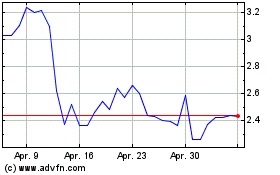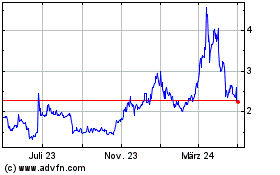How Web3 Will Aid in a New Era of Credential Data Ownership and User Empowerment
14 Juli 2022 - 8:29PM
NEWSBTC
The first thing that comes to mind when thinking of Web3 might be
the likes of NFTs, the metaverse or blockchain technology. Although
all of these concepts do fall under the umbrella that is Web3,
additional features such as credential data networks also fit into
the picture, which play an integral part in the progression of
Web3. Back to Basics The current structure of the internet (as we
know it today), often labelled as Web2, allows for user-generated
content to be posted on a number of different channels. As opposed
to the first version of the internet that was stagnant and limited
to “read only”, the internet has moved to a structure which allows
users to generate their own content as well as interact with it,
such as one posting an image to their social profile, while other
users like, comment and share the content. With technology ever
changing at rapid speeds, Web3 is believed to be the next step in
the transition of the web. Often dubbed as “the future of the
internet”, Web3 is a decentralised version of the web, which
integrates the likes of cryptocurrencies, NFT’s, DAOs, and
decentralised finance into one space. With this being said, Web3
offers a magnitude of web versions which can be read, written or
owned, allowing users to have financial stake and control over
online communities that they belong to. One of the largest and
possibly most disregarded aspects that differentiate Web3 from
Web2, is the credential data networks that live on Web3. Wait, What
are Credentials? In technical IT terms, credentials refer to the
verification of one’s identity online, similar to that of an ID
card or passport, but on the web. However, this online identity
does only pertain to one’s username and password, but rather the
behavioural patterns that are specific to the user. “How much time
does a user spend on a specific app before going onto the next?”
and “Which features of the app do users use most?” could be common
questions that organisations might ask when wanting to figure out
how to optimise the user experience and create seamless apps.
Traditionally speaking, credential data of users is stored on a
centralised server of the website in question. For example, if a
user creates an account on Meta (previously known as Facebook),
their personal data (together with the data of all other
users) will be stored on Facebook’s central server. At first
glance, this may not seem like an issue, however, the risk of
personal data being breached is extremely high, with 2021 seeing
530 million Facebook users personal data being breached. Web3 To
Save The Day With the high risk of credential data being breached
in Web2 – it’s time for Web3 to save the day. The decentralised
format of Web3 allows for data to be stored across a number of
“scattered” ledgers, referred to as blockchain technology. By
utilising blockchain technology for data storage – the possibility
of one hacking and gaining access to this data is decreased
significantly, with some believing it to be near impossible to
crack. Not only is the potential for data to be compromised much
lower in Web3, but the data ownership is no longer in the hands of
central organisations such as Meta or Google. This new age
technology allows users to own and control their own data, thanks
to the power of credential data networks. The Ins and Outs of Web3
Credential Data Networks The largest Web3 credential data network
in the world, Project Galaxy, allows Web3 developers and projects
to leverage credential data in order to help them build better
products and communities. Through Project Galaxy’s open and
collaborative infrastructure, data curators have the opportunity to
be rewarded when their credentials are used in Project Galaxy’s
multiple Application Modules including Credential Oracle Engine and
Credential API. The aim of Project Galaxy is to allow users to take
ownership of their own data, having the possibility to monetise
through curating digital credentials, and contributing to the data
network. This ecosystem will be made possible through their open
and collaborative data network that is accessible to all Web3
developers. But Wait, There’s More The concept of credential data
on Web3 seems to be making waves, with Ethereum co-founder Vitalik
Buterin working on a new project known as “Decentralised Society:
Finding Web3’s Soul”, where a fully decentralised society can be
created through Soulbound NFTs or Tokens (SBT). These SBT’s are
non-transferable forms of identity (in the form of tokens), which
will allow individuals to verify their information and identity
using blockchain technology. Information that will be verified
through SBT’s includes a long list such as educational background,
medical certificates and more. Although the idea of SBT’s may seem
to be far-fetched for now, Project Galaxy is already at the
forefront of this concept. Already in use by over 500 partners,
non-transferable credential based NFTs are already supported by
Project Galaxy, which works on the exact same premise as SBT’s.
Where To From Here? Up until now, the current state of the internet
has been not only stagnant but also has seen issues relating to the
safety of users personal data. The possibilities of Web3 giving
people the power to control and own their personal data is looking
to become a reality through Web3 credential data networks. Project
Galaxy and the concept of Soulbound NFTs/tokens are taking centre
stage in this new revolution of credential data safety. Will
credential data networks such as make the move to Web3 possible, by
giving users the empowerment to own and control their own data on
open, collaborative networks? Is this the future of the internet?
Only time will tell…
Waves (COIN:WAVESUSD)
Historical Stock Chart
Von Okt 2024 bis Nov 2024

Waves (COIN:WAVESUSD)
Historical Stock Chart
Von Nov 2023 bis Nov 2024


